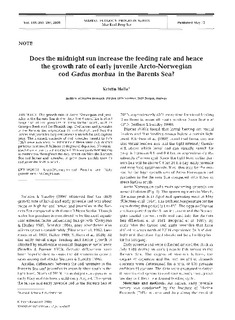| dc.contributor.author | Helle, Kristin | |
| dc.date.accessioned | 2007-06-13T10:40:43Z | |
| dc.date.issued | 2000-05-12 | |
| dc.identifier.issn | 0171-8630 | |
| dc.identifier.uri | http://hdl.handle.net/11250/108338 | |
| dc.description.abstract | The growth rate of Arcto-Norwegian cod juveniles in the Barents Sea during their first 4 mo of life is about twice that of cod juveniles in areas farther south, such as Georges Bank and the Flemish cap. Cod larvae and juveniles in the Barents Sea experience 24 h of daylight and thus the larvae and juveniles may continuously search for and capture prey. The stomach contents of cod juveniles caught in July 1989 were examined to determine if there were any diurnal patterns in stomach fullness or degree of digestion. No significant diurnal trends were detected. This suggests that feeding is continuous throughout the day, which enables the Barents Sea cod larvae and juveniles to grow more quickly than do cod juveniles farther south. | en |
| dc.format.extent | 564945 bytes | |
| dc.format.mimetype | application/pdf | |
| dc.language.iso | eng | en |
| dc.subject | cod | en |
| dc.subject | torsk | en |
| dc.title | Does the midnight sun increase the feeding rate and hence the growth rate of early juvenile Arcto-Norwegian cod Gadus morhua in the Barents Sea? | en |
| dc.type | Journal article | en |
| dc.type | Peer reviewed | |
| dc.source.pagenumber | 293-297 | en |
| dc.source.volume | 197 | en |
| dc.source.journal | Marine Ecology Progress Series | |
| dc.identifier.doi | http://dx.doi.org/10.3354/meps197293 | |
